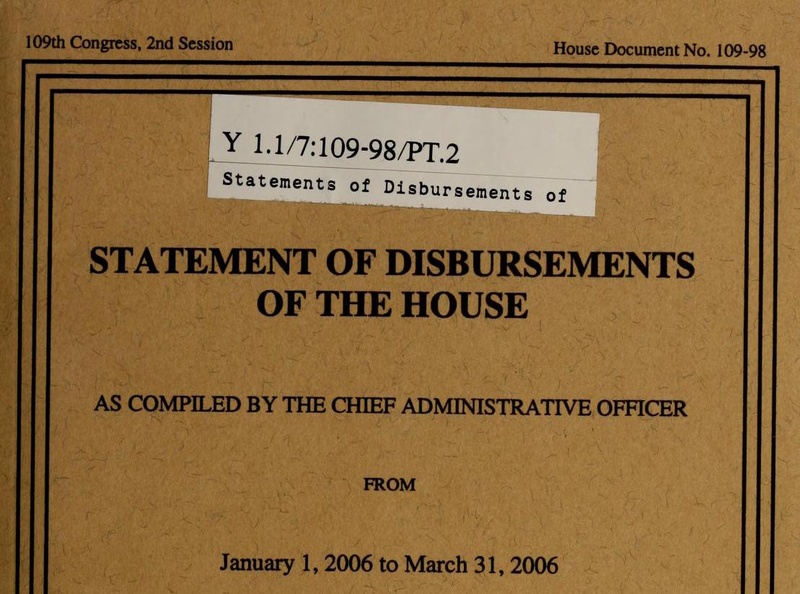House makes spending data available in easy-to-use format

Great news for open and accessible government: The U.S. House of Representatives has decided to release a machine-readable CSV file of the quarterly “Statement of Disbursements.” This report details how the House and its lawmakers spend taxpayer money, and having it available in an easy-to-use format enables more effective analysis and oversight.
Since 2009, Sunlight has collected the PDF reports and converted them to searchable CSVs. But now you can download the newly released files directly at the House disbursements page. These include all the spending conducted by the offices of 435 members of the House, as well as delegates, committees, leadership and the House’s Chief Administrative Office, which oversees the release of this and other reports.
These reports are an important tool for accountability that lets the public look into how Congress spends taxpayer dollars. Including how much is spent on everything from tech spending to travel to staff salaries to meals eaten at Chick-Fil-A. Sunlight and other news outlets have used this database to write numerous stories, including analyses of congressional capacity during reduced operating budgets, staff turnover among members’ offices, and the lack of information on lawmakers’ traveling budgets.
Do your reps dine on @ChickfilA? Find out that—and a lot more—with our House spending data: https://t.co/mZShmR6qjd pic.twitter.com/aw1gCVE19Q
— Sunlight Foundation (@SunFoundation) March 28, 2016
Overall, the House has come a long way since deciding to post disbursements in PDF format, and this decision builds on that success. Daniel Schuman of Demand Progress, who has helped lead the call for Congress and the federal government to publish data in this way, congratulated the House reiterated the importance of this information, stating “the Disbursements data can tell you a lot about the health and activities of Congress.”
This news comes as other types of legislative information is made public in a an easy-to-use format, including the House Rules, which is critical to how the House conducts its business.
For seven years, Sunlight made an effort to take House spending information and turn it into a CSV — which can be read using Excel or other spreadsheet applications — allowing anyone to easily dig into the data. Since the House has undertaken this task now, there are no plans to continue compiling the reports on our database; however, we will maintain an archive of quarterly reports in CSV format dating back to the third quarter of 2009. We are looking forward to exploring the new report format to see presents House spending data.
And let’s not forget about the Senate. We urge the Senate to follow the House’s lead and release their expenditures in a structured format. The Secretary of the Senate currently publishes Senate expenditures only twice a year in hard-to-parse PDF files, making it much harder to use. Until the Senate changes its ways, you can view our efforts to publish Senate spending data in a CSV file here.
How did we get here?
To start, the decision to publish the information in a CSV came after a bipartisan review of “standards and procedures in an effort to clarify House regulations and practices” led by Reps. Rodney Davis, R-Pa., and Zoe Lofgren, D-Calif. On Oct. 21, 2015, the Committee on House Administration voted and passed several measures governing spending by House members, one of which was to publish House spending information in a CSV format.
In statement released shortly after the vote, House Administration Committee Chair Candace Miller said:
Each Member is sent to Washington to represent their constituents’ views and advocate on their behalf. This requires each Member’s actions to reflect their constituents’ interests as well – not just how we vote on the House Floor, but also how we spend our official representational budgets. And it is this Committee’s responsibility to help provide that process of accountability. The resolution we adopted today provides new controls and clarity for spending regulations where needed, and will institute more transparency in the disclosing of expenditures.
A spokesperson for the committee added that the House will continue to post CSVs starting with the first quarter of 2016. Additionally, the House will archive all CSV files in a similar fashion to how the PDF files are saved.
Both Davis and Lofgren said the measures will create more transparency and accountability in the House. Lofgren went on to say “Today is a solid start, but there remains more work to do…”
We agree and we can’t wait to continue this good work with both the House and the Senate.

